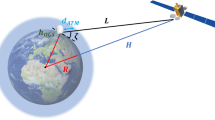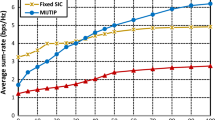Abstract
End-to-end performance of broadband satellite links operating at Ku band and above is studied in this paper. The problem of power control in terms of optimal power allocation and maximization of the total carrier-to-interference-and-noise ratio is considered. More specifically, the paper proposes the use of Fuzzy Inference Systems (FIS) to optimize power allocation in a dual-hop (end-to-end) satellite system, considering the general case of dual-polarized satellite links with transparent satellite transponder. The quality of the link is assessed through the FIS based on the predicted values of rain attenuation induced on the corresponding links and the interference-to-noise ratios. According to this estimation, the satellite hub-station increases or reduces the allocated uplink power. The proposed scheme’s effectiveness is investigated in terms of carrier-to-noise plus depolarization plus interference ratio and power consumption for 30/20 GHz frequency in the uplink and the downlink respectively. A variety of conditions is considered regarding the rain attenuation values from 0 (no rain) to 30 dB and interference-to-noise ratio from −15 to 15 dB to both links. Finally, the scheme is compared to step-based power control algorithms, showing that it can significantly reduce the total consumed power.
Similar content being viewed by others
References
Morello A., Mignone V. (2006) DVB-S2: The second generation standard for satellite broad-band services. Proceedings of IEEE 94(1): 210–227
ETSI EN 301 790. (2003). Digital video broadcasting (DVB); Interaction channel for satellite distribution systems.
Panagopoulos, A. D., Arapoglou, P.-D. M., & Cottis, P. G. (2004). Satellite communications at Ku, Ka, and V bands: Propagation impairments and mitigation techniques. IEEE Communication Surveys & Tutorials, 6(3) Third Quarter.
ITU-R SF Series Recommendations on. Frequency sharing and coordination between fixed-satellite and fixed service systems.
Dissanayake A. W. (1997) Application of open-loop uplink power control in Ka-band satellite links. Proceedings of IEEE, 85(6): 959–969
Aroumont A., Castanet L., Bousquet M. (2009) A study on SNR estimation algorithms for channel state estimation in communication satellite systems employing fade mitigation techniques. Space Communications 22(1): 31–40
Fuzzy Inference Systems: Tutorial (Fuzzy Logic Toolbox). http://www.mathworks.com/access/helpdesk/help/toolbox/fuzzy/fp351dup8.html.
Tsay Mu-King, Lee Ze-Shin, Liao Chien-Hsing (2008) Fuzzy power control for downlink CDMA-based LMDS network. IEEE Transactions on Vehicular Technology 57(6): 3917–3921
ITU-R Recommendation P.618-12. (October 2009). Propagation data and prediction methods required for the design of earth-space telecommunication systems.
Panagopoulos A. D., Kanellopoulos J. D. (2003) On the rain attenuation dynamics: Spatial-temporal analysis of rainfall rate and fade duration statistics. International Journal of Satellite Communication and Networking 21(6): 595–611
Panagopoulos A. D. (2009) Time varying interference statistical distribution for direct-to-user satellite applications. IEEE Communication Letters 13(6): 387–389
ITU-R P. 837-5 (2007). Characteristics of precipitation for propagation modeling.
Sakarellos V. K., Skraparlis D., Panagopoulos A. D., Kanellopoulos J. D. (2009) Optimum placement of radio relays in millimeter-wave wireless dual-hop networks. IEEE Antennas and Propagation Magazine 51(2): 190–199
Maral, G., Bousquet, M. (1998). Satellite communications systems, techniques and technology (3rd edn). NewYork: Wiley, ISBN 0471970379.
ITU-R Study Group 3 Databank. http://www.itu.int/ITU-R/index.asp?category=study-groups&rlink=sg3-dtbank-vhf-uhf&lang=en.
COST Project 25. (2002). Radiowave propagation modeling for satcom services at Ku band and above. Final Report, ESA Publication Division, ISBN 92-9092-608-2.
Ippolito, L. J. (1989) Propagation effects handbook for satellite systems design—a summary of propagation impairments on 10 to 100 GHz satellite links with techniques for system design, NASA reference. Publication 1082(04), Washington, D.C.
Berger, H., Bever, M., & Jue, R. (2002). An air interface for high bandwidth systems. 20th AIAA international communication satellite systems conference and exhibit.
Castanet, L., Mertens, D., Bousquet M. (July–August 2002). Simulation of the performance of a Ka-band VSAT videoconferencing system with uplink power control and data rate reduction to mitigate atmospheric propagation effects. International Journal of Satellite Communications, 20(4),231–249
Bolea-Alamanac, A., Bousquet, M., Castanet, L., & Van de Kamp, M. (2003) Implementation of short-term prediction models in fade mitigation techniques control loops. Joint COST 272 / 280 Workshop, ESA/ESTEC, Noordwijk, The Netherlands.
Author information
Authors and Affiliations
Corresponding author
Rights and permissions
About this article
Cite this article
Charilas, D.E., Panagopoulos, A.D. & Chaloulos, K.S. Fuzzy-Based Uplink Power Control in Forward Broadband Satellite Links. Wireless Pers Commun 68, 1565–1581 (2013). https://doi.org/10.1007/s11277-012-0539-0
Published:
Issue Date:
DOI: https://doi.org/10.1007/s11277-012-0539-0




